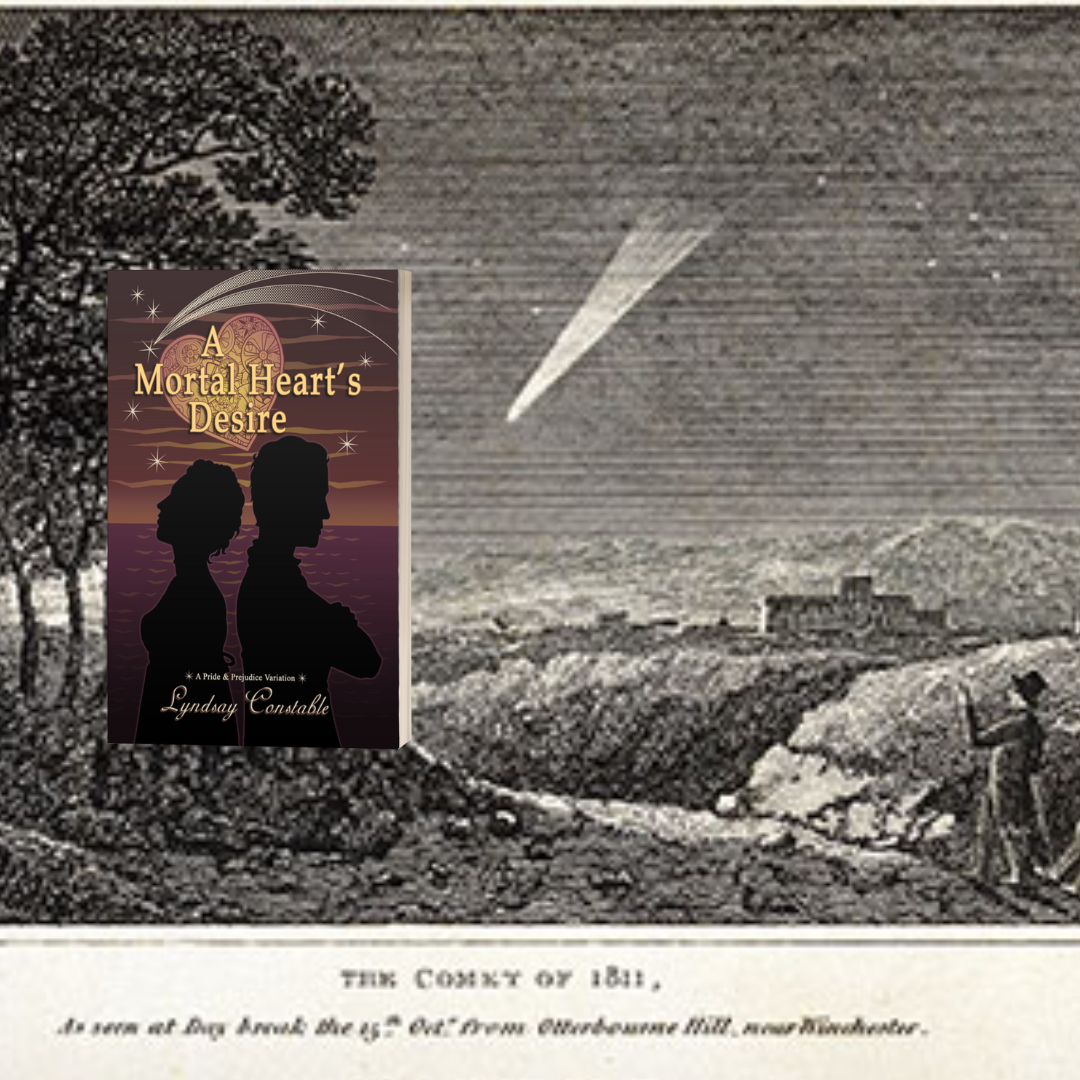1811 was an incredibly busy year for our little planet. Comets, earthquakes, and the first steamship to travel down and up the Mississippi River. In my new novel, A MORTAL HEART’S DESIRE- A Pride and Prejudice Variation, all three of these events are major players in the action.

The people of Paris reacting to the Great Comet
The Great Comet of 1811 was streaking across the night sky for an incredible 260 days in 1811 and 1812. Bright and long, and with a twin tail, it must have been an amazing sight, even by today’s standards with our greater scientific knowledge. It was occasionally spanning from horizon to horizon. Jane Austen would absolutely have seen it. I love to imagine that Elizabeth and Darcy were perhaps watching the comet during their rollercoaster courtship! At the time, people speculated as to what it was made of, did people live on it, was it an evil omen, and would it crash into Earth. For those who didn’t have access to books or periodicals, or were unable to read, it would have been terrifying to witness. In WAR AND PEACE. Tolstoy refers to The Great Comet-
It was clear and frosty. Above the dirty, ill-lit streets, above the black roofs, stretched the dark starry sky. Only looking up at the sky did Pierre cease to feel how sordid and humiliating were all mundane things compared with the heights to which his soul had just been raised. At the entrance to the Arbát Square an immense expanse of dark starry sky presented itself to his eyes. Almost in the center of it, above the Prechístenka Boulevard, surrounded and sprinkled on all sides by stars but distinguished from them all by its nearness to the earth, its white light, and its long uplifted tail, shone the enormous and brilliant comet of 1812—the comet which was said to portend all kinds of woes and the end of the world. In Pierre, however, that comet with its long luminous tail aroused no feeling of fear. On the contrary he gazed joyfully, his eyes moist with tears, at this bright comet which, having traveled in its orbit with inconceivable velocity through immeasurable space, seemed suddenly—like an arrow piercing the earth—to remain fixed in a chosen spot, vigorously holding its tail erect, shining and displaying its white light amid countless other scintillating stars. It seemed to Pierre that this comet fully responded to what was passing in his own softened and uplifted soul, now blossoming into a new life.

A humorous illustration of people observing the comet and doctors warning of neck damage for staring at it for too long.
The Great Comet of 1811(sometimes referred to as Napoleon’s Comet) will make a return to earth in the year 4700. I hope we are still reading Jane Austen when her comet returns!

An illustration of the New Madrid Earthquake
The New Madrid Earthquake of 1811 was a series of 4 large quakes ranging between 7.5 and 8.5 in magnitude. With 2000 aftershocks, it was an enormous natural event that could be felt all the way to Washington D.C. and awoke President Madison and his wife in the middle of the night. The first one was of the same magnitude as the San Francisco Earthquake of 1906, but felt over an area of 50,000 square miles compared to 6,000 for the San Francisco quake. The 1811 quake near the confluence of the Mississippi and Ohio Rivers “sank” islands, destroyed villages, caused lakes to disappear and new ones to appear, and caused the Mississippi to run north for several minutes. Scientific thinking of the time was under the false assumption that all major natural disasters had occurred in ancient times and no longer happened in “modern” times. All of this was happening under an enormous, unusual comet. And in the middle of it was the New Orleans steamboat.

A later image of steamboats traveling on the Mississippi River. No image of the New Orleans seems to have survived.
The New Orleans was a steamboat that had an English Boulton and Watt engine, two paddlewheels, one mast, and a bright blue bowsprit. Though I searched long and hard, I could not find a drawing of this incredibly important boat. After it sank in the Mississippi several years after its historic voyage, some of the details I mentioned above were uncovered during a drought and are some of the few facts we have. It was such an epic moment in the course of technology. Goods could be transported down and UP a powerful, large river! Steam engines had been used in a smaller capacity on canals and calmer waters, but never in such a wild environment. The major challenge was the Falls of the Ohio, a small but highly treacherous drop in the Ohio River, most of which has been smoothed over by dams and engineering today. It must have been a wild ride for Nicholas Roosevelt and his very pregnant wife, Lydia. He was the brother of President Teddy Roosevelt’s great grandfather and according to all accounts, a larger-than-life character.

FALLS of the OHIO RIVER- The river falls 26 feet in 2.5 miles and was incredibly treacherous at the best of times and impassable during droughts
1811 was an amazing year and I wonder how much Jane Austen saw of the Great Comet and heard about the New Madrid Earthquakes. Did she also read about the voyage of the New Orleans? It certainly made the news of the day, but was perhaps overshadowed by the shock of the earthquake.


